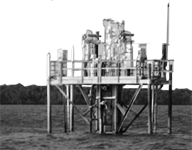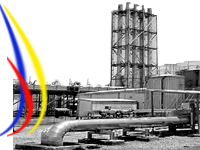Regional Stratigraphy:
The break up of Gondwana initiated the formation of basement-controlled coastal and early interior basins. The Precambrian basement, penetrated by three wells, and exposed at the edges of the basins, consists of high grade metamorphic rocks, mostly gneisses. The early depositional history of the coastal basins was initiated in the Late Paleozoic, (Carboniferous?) or Permo-Triassic and continued through the rift phase until the end of the Early Jurassic (Karoo of some authors). The rift phase, or synrift stratigraphic units, from the top of basement to the end of Early Jurassic, are best represented in the Selous, Ruvu, Mandawa, and Ruvuma basins of eastern Tanzania, and in the Rukwa Basin in the southwest. In the Selous Basin, the Carboniferous to Permo-Triassic interval consists of about 10 km of fluvial, deltaic, continental and lacustrine deposits of the Dwyka and Stigo Series, overlain by the Triassic Tanga Beds (Figure 6). This sequence is, in part, equivalent to the Lower Sakamena source rocks of Madagascar. In the Mandawa Basin, the Tanga Beds are overlain by clastics and evaporites of the Nondwa Formation (Early Jurassic). Significant thicknesses of salt are associated with these sediments and have been identified throughout the basin. Pre Middle Jurassic sections are also preserved in the Rufiji Trough and Dar es Salaam Platform. From Middle Jurassic onwards, the coastal basins were established as the continental shelf of a passive margin and subjected to various deltaic and marine depositional environments. Several transgressive and regressive phases resulted in 4,000 m of Mesozoic and another 4,500 m of Tertiary sediments being deposited. These sediments consist of marine marls, shales, sandstones and limestones.
In the interior basins deformation commenced in the carboniferous with an estimated 4000 m of Karoo deposits. Further thicknesses of up to 2000 m of continental sandstones and shales were deposited during the late Jurassic and early Cretaceous eras. The post-rift phase started in the Middle Jurassic with a regional unconformity, and initiated a marine transgression, accumulating thick shales of the Makarawe Formation and limestones of the Kidugalo and Mtumbei Formations. The regional unconformity separated the Karoo continental deposits from the marine Jurassic sediments. North of the Kisarawe-1 well, the Jurassic has not been reached by drilling. The seismic control suggests that the Jurassic is buried very deep offshore, beneath the thick Cretaceous-Tertiary cover. The Middle to Late Jurassic transgression was followed by regression in the Early Cretaceous, resulting in predominantly clastic sediments in the south, including the Neocomian Songo Songo reservoir sandstones of the Kipatimu Formation, and limestones and conglomerates in the north. A regional Middle Cretaceous unconformity and the deposition of thick platform carbonates culminated the regression and initiated another major marine transgression in the Late Cretaceous. This resulted in the deposition of the shelf sands and slope shales of the Ruaruke Formation. At this time there was also some tectonic activity resulting in the development of several fault systems separating the shallow marine environment in the west from the deep marine environment in the east.
Paleocene deposition was associated with the last phase of transgression continuing from Late Cretaceous times and with contemporaneous subsidence in the coastal and offshore areas. Several uplifts occurred in the Late Tertiary, represented by unconformities at the base of the Eocene and Miocene, followed by Middle Eocene to Recent regressive sediments of continental, deltaic and marine facies. In the interior basins a late phase of deposition occurred during the late A number of oil seeps and slicks have been reported from the Interior Rift Basins. Oil seeps were reported from Lake Tanganyika, as early as 1896, and in more recent times, project PROBE found an oil film on the lake. Oil shows have been reported from the Pemba-5, Mandawa-7, Mafia-1, Mita Gama-1 wells. Cut fluorescence and staining from seven other wells and three boreholes have been observed. Songo Songo wells yielded small amounts of oil, which are low in sulfur with 33E - 47E API.
Gas Discoveries:
Commercial gas discoveries have been made at Songo Songo and Mnazi Bay, while gas shows have been encountered in several wells and boreholes. Gas seeps have been reported from several localities in the coastal and inland basins.
Songo Songo Gas Field:
The field is located on and offshore Songo Songo Island (Figure 7), about 15 km from the mainland and 200 km south of Dar es Salaam.The discovery well, Songo Songo-1, was drilled in l974 by AGIP. Songo Songo is a large N-S trending structure containing one to two TCF of gas reserves. The gas is contained in Lower Cretaceous inner shelf sand reservoirs with porosities averaging greater than 20%, and net porous intervals up to 155 m thick. The structure was uplifted during the Early Cretaceous and the reservoir modified by the Mid Cretaceous regional unconformity. The trap consists of two faulted highs separated by a saddle. A series of N-S and NW-SE trending faults step down to the east. This faulting, regional eastward tilting, and rapid Tertiary sedimentation created more growth faults which mostly sole out in the sealing shales of the Upper Cretaceous Ruaruke Formation. The Lower Cretaceous reservoirs are not affected by this later episode of faulting. Continued activity along these faults resulted in the development of broad, low relief anticlines. The gas appears to have been sourced from post mature organic material of Jurassic or Early Cretaceous age. The associated liquids are probably sourced from mature organic matter of Early Cretaceous and Middle Cretaceous age and seem to have migrated from a nearby basin.
Mnazi Bay Gas Discovery:
AGIP drilled the discovery well, Mnazi Bay-1, in l982. The well encountered commercial quantities of gas in two Oligocene sands within the Mnazi Bay Clay Formation. These sands have porosities of 15 to 25% and permeabilities up to 560 md. Drill stem tests produced flows of 3.5 x 105 m 3 / day (12.5 MMCF/d). Based on one well and existing seismic coverage, the reserves at Mnazi Bay are estimated to be in the 1 TCF range. The gas is considered thermogenic but no source identification has been made.

